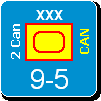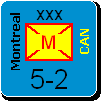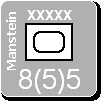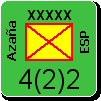Shannon V. OKeets
Posts: 22095
Joined: 5/19/2005
From: Honolulu, Hawaii
Status: offline

|
quote:
ORIGINAL: Blorsh
So IMO, al MWIF the live will be harder for German "peecekeeper" at Finland, because the russian units will have more space (european scale hexes, not ASA like board game) to manouvre around german units, and in the case german units are at coastal hexes and the russian units pass around them, the germans can no cut their supply, so the MWIF will be have different strategies from board game.
I have the old CWiF, and at China the japanese advance is very different, the game rules are the same, but with different map scale is very different.
At CWiF there is a bug that when at naval intercepetion the interceptios is succesful is not possible to attack only the moving units, you have to attack naval units at one sea box also, and at rules example:
"Heinz rolls a ‘5’. The other units in the sea-box are not included in the first combat round, so only the moving units will fight."
I expect this will be corrected at MWIF
Yeah, the beta testers have reported some problems with naval interception (inherited from CWIF). I have made a lot of changes to the naval interception and naval combat code from CWIF. Somewhere in the threads of this forum there is a detailed explanation of the sequence of play (section 7 of the Players Manual). If you can find that thread, it contains the whole gory story. Here is an except from the Players Manual on naval combat:
===
7.10 Naval Combat Subphases
Naval combat can be initiated from 3 places in the sequence of play: Naval Combat by Phasing Side phase, Naval Combat by Non-Phasing Side phase, and Naval Interception digression. Naval interception digressions can occur during numerous phases. Once a naval interception combat has been resolved, with any naval combat aborts also completed, the sequence of play returns to the phase where the naval interception occurred.
The two naval combat phases start with the selection of a sea area (see section 7.10.1) while naval combat interception digressions skip that subphase and begins with the subphase Naval Air Support by the Initiating Side (see section 7.10.2). Note that the initiating side is the phasing side, except during naval interception combats; then it is the side which moved naval units into the sea area - the side which was intercepted.
7.10.1 Select Sea Area (RAC 11.5.2)
Depending on whether it is the Naval Combat by Phasing Side or Non-Phasing Side, one major power on the phasing/non-phasing side is designated the decision maker for each sea area. The Naval Combat Overview form (see section 8.7.2.28) is shown to all players, although a sea area can be selected for combat only by the designated major power for that sea area (i.e., the major power on the phasing/non-phasing side with the most units in the sea area). That decision maker is also the only one who can decline combat in that sea area.
If any of the decision makers selects a sea area for naval combat, that person designates which naval unit is initiating the combat. Note that the decision maker does not have to choose one of his own units, just one of the units on his side that is eligible to initiate the naval combat. The initiating unit may have been identified previously (e.g., in a naval interception during the naval movement phase, the intercepting unit can be used as the initiating unit in the ensuing Naval Combat by Non-Phasing Side phase). After the initiating unit has been determined, MWIF advances the sequence of play to the subphase Naval Air Support by the Initiating Side.
Once all sea areas where combat may occur have either been selected or declined, the naval combat phase ends and MWIF advances the sequence of play to the next phase (either the Naval Combat by Non-Phasing Side phase or the Strategic Bombing phase).
7.10.2 Naval Air Support by Initiating Side (RAC 11.5.3)
In this subphase the major powers on the initiating side can fly land based air units into the sea area in support of the current naval combat. As ‘interceptors’ these units have only half their normal range. Once all major powers on the initiating side have clicked on the End of Phase button in the main form, this subphase is over and MWIF advances the sequence of play to the subphase Naval Air Support by the Non-Initiating Side.
7.10.3 Naval Air Support by Non-Initiating Side (RAC 11.5.3)
This subphase is the same as the preceding one but for the major powers on the non-initiating side.
7.10.4 Commit Submarines (RAC 11.5.4)
In this subphase both sides decide whether or not to commit their submarines to the combat. The side that initiated the combat decides first. If the naval combat is an interception combat, then the side that successfully intercepted (the non-initiating side) has already decided whether or not to include its subs.
The decision making major power on each side is the major power with the most units in the sea area. The Commit Subs form is used for this decision (see section 8.7.2.11). Once both sides have closed the Commit Subs form, this subphase is over and MWIF advances the sequence of play to the next subphase.
7.10.5 Search Die Rolls (RAC 11.5.5)
The first thing done in this subphase is to make sure that both sides have units committed to the naval combat. It is possible that one side had only submarines and decided to not commit their subs. In that case, the combat is over.
Assuming that a naval combat is still possible, MWIF generates random numbers to simulate rolling dice for the search rolls for both sides. During port attacks the non-phasing side has fixed numbers for their die rolls: 5 for a major port and 3 for a minor port. MWIF figures out which sides had successful search rolls and informs everyone as to what happened.
There are 3 possible outcomes of the search rolls:
• Neither side succeeds - the combat is over.
• Both sides succeed - MWIF records this fact and advances the sequence of play to the next subphase.
• One side succeeds and the other fails - MWIF records who ‘won’ and advances the sequence of play to the next subphase.
7.10.6 Select Included Sea Boxes (RAC 11.5.5)
If both search rolls were successful, then which sea box sections are included is ordained by the rules and recorded by MWIF. If only one side was successful, MWIF lets the winning side choose which sea box sections for the losing side are included in the combat (see section 8.7.2.48). Either way, once the included sea box sections are known, MWIF advances the sequence of play to the next subphase.
7.10.7 US Decides Whether to Include Units (RAC 13.3.2, US Entry Options)
Under certain conditions, the US has the option of including some of its combat units in the naval combat, even though the US is not at war with the Axis. These are US Entry options 11, 20, 29, and 38. It might also have some of its convoys included if US Entry option 32 has been chosen. This subphase is skipped if none of the those US Entry options have been selected or is US Entry option 50, unrestricted naval warfare, has been chosen. The addition of US Entry option 50 means that the US units will have already ben committed in the previous subphase.
Once the US player has decided what, if any, units to include (see section 8.7.2.56), MWIF advances the sequence of play to the next subphase.
7.10.8 Naval Combat Surprise (RAC 11.5.6)
Depending on the search numbers and sea box sections, MWIF calculates which side has surprise points available. There might be none, and if there is only 1, then there is no way to spend it. Either way, MWIF skips this subphase and advances to the Select Combat Type subphase.
If one side has surprise points, the decision maker for that side for this combat now gets the opportunity to spend them (see section 8.7.2.52). One of those choices might be to avoid combat altogether. If that choice is selected, then the combat is over.
Assuming that the combat is not over, MWIF advances the sequence of play to the next subphase as soon as the decision maker closes the Surprise Points form.
7.10.9 Select Combat Type (RAC 11.5.7 & 11.5.6)
Determining the naval combat type is a series of decisions:
1. The side that has surprise may have chosen the naval combat type (if they chose naval air and the weather prevents a naval air combat, then the combat is over).
2. If the weather permits naval air combat, and the initiating side has a unit capable of naval air combat (see RAC section 11.5.7), the initiating side can choose naval air combat.
3. Same as #2 but for the non-initiating side.
4. If the initiating side has a unit capable of submarine combat and the non-initiating side has convoys present, the initiating side can choose submarine combat.
5. Same as #4 but with the roles reversed.
6. If none of the above has been chosen, it is a surface combat.
Once the combat type has been decided MWIF advances the sequence of play based on the combat type:
• Naval air combat - Air-to-air Combat subphase (see section 7.10.10),
• Submarine combat - Anti-air Combat by Non-Initiating Side subphase (see section 7.10.11), or
• Surface combat - Surface Attack by Initiating Side (see section 7.10.15).
7.10.10 Air-to-air Combat (RAC 11.5.9 & 11.5.6)
Naval Air combat starts with identifying all the carrier air units included in the combat and separating them from their carriers; they fly into battle. When not playing with the optional rule Carrier Planes, for each participating carrier MWIF creates a temporary carrier air unit, which players manipulate at various points in the naval air combat (e.g., assigning whether the unit is a fighter or bomber, and arranging units for air-to-air combat). These temporary carrier air units have air-to-air and air-to-sea factors equal to the class of the carrier they represent. The air-to-air factor is used when the temporary air unit flies as a fighter and the air-to-sea factor when it flies as a bomber.
Regardless of whether the optional rule Carrier Planes is being used, MWIF then lets all players, simultaneously, decide which of their engaged air units are flying as fighters and which are flying as bombers. Only fighter-bombers and carrier air units have this flexibility, and even for them there are many cases where the unit must fly as a fighter (e.g., if the unit has an air-to-sea factor of zero).
After all air units have been assigned a role as either fighter or bomber (see section 8.7.2.32 for details of using the Plane Role form), a standard air-to-air combat is performed (see section 7.9). If zero bombers survive the air-to-air combat, MWIF advances the sequence of play to the subphase 7.10.21, Voluntary Side Abort by Initiating Side. Otherwise, the sequence of play advances to the subphase Anti-air Combat by Non-Initiating Side.
7.10.11 Anti-air Combat by Non-Initiating Side (RAC 11.5.9 & 11.5.6)
If there are no bombers from the initiating side remaining in the attack, MWIF skips this subphase and advances the sequence of play to the subphase Anti-air Combat by Initiating Side. Conversely, if there are bombers from the initiating side left, they are subject to anti-aircraft fire (see RAC 11.5.9). Then once again MWIF checks to see if there are bombers from the initiating side remaining in the attack.
If some bombers from the initiating side remain, MWIF advances the sequence of play to the subphase Naval Air Attack by Initiating Side. Otherwise, it skips to the subphase Anti-air Combat by Initiating Side.
7.10.12 Naval Air Attack by Initiating Side (RAC 11.5.9 & 11.5.6)
This subphase executes the actual naval air attack by the initiating side’s bombers on the non-initiating side’s naval units. MWIF uses the naval combat results table to determine what damage was inflicted, if any. The four possible results are: no effect, aborted, damaged, and destroyed.
The team leader for the initiating side chooses the first target and the sides alternate choosing targets thereafter. If one side had the advantage of surprise and spent surprise points to choose a target, then they get to choose the target when normally their opponent would choose. That is, the side that doesn’t have surprise loses its ‘turn’ to choose a target, and the other side chooses 3 in a row (or more if more surprises points were spent on choosing targets). See section 8.7.2.30 for details concerning the use of the Naval Combat Results form.
As the target for each result is determined, MWIF processes those results by generating a random number. Depending on the defense factor of the target and the generated random number, the target either receives the result indicated, or a result “one less” severe. See RAC section 11.5.8 for details about this and other naval combat results. Should convoys receive adverse results, MWIF automatically splits a large convoy unit into smaller ones. For example, if one convoy is destroyed, MWIF will split a 4 point convoy unit into a 3 point unit and a 1 point unit, and destroy the 1 point convoy.
Any aborting land based air units are placed in the Return To Base Stack and returned to a land hex at the end of the combat round. Naval units which have aborted are placed in the Naval Combat Abort Queue and processed after this naval combat is completely over (see section 11.13.6).
Regardless of the naval combat results, all carrier air units are returned to their carriers at the end of the naval combat round. Damaged naval units remain in the sea area and may end up participating in future naval combat rounds of this naval combat. However, once this naval combat is completely over, all damaged naval units are placed in the Naval Abort Queue and processed the same as other units therein (see section 11.13.6).
After this subphase is over, MWIF continues the current naval combat round by advancing the sequence of play to the subphase Anti-air Combat by Initiating Side.
7.10.13 Anti-air Combat by Initiating Side (RAC 11.5.9 & 11.5.6)
This is the same as 7.10.11 except the sides are reversed. When this subphase is over, MWIF advances the sequence of play to either Naval Air Attack by Non-Initiating Side, or skips that subphase and advances to end of naval combat round processing (as described in 7.10.12).
7.10.14 Naval Air Attack by Non-Initiating Side (RAC 11.5.9 & 11.5.6)
This is the same as 7.10.12 except the sides are reversed. When this subphase is over, MWIF advances the sequence of play to the end of naval combat round processing (as described in 7.10.12).
7.10.15 Surface Attack by Initiating Side (RAC 11.5.8 & 11.5.6)
Both sides must have surface naval units included in the combat for this type of combat to take place. If either side does not, then MWIF advances the sequence of play to end of naval combat round. Usually, if MWIF processes to this subphase a naval surface combat occurs.
A surface naval combat is the simplest of the 3 types of naval combat. MWIF counts how many surface factors the initiating side has, counts the number of ships the non-initiating side has, and performs a table lookup using the naval combat results table. The processing of the results is the same as described in section 7.10.12.
After this subphase is over, MWIF continues the current naval combat round by advancing the sequence of play to the subphase Surface Attack by Non-Initiating Side.
7.10.16 Surface Attack by Non-Initiating Side (RAC 11.5.8 & 11.5.6)
This subphase is identical to the previous one except the sides are reversed. When this subphase is over, MWIF advances the sequence of play to the end of naval combat round processing (as described in 7.10.12).
7.10.17 ASW Attack by Non-Initiating Side (RAC 11.5.10, 22.4.19, & 11.5.6)
A submarine naval combat starts with the non-initiating side using its ASW (anti-submarine warfare) units to attack the initiating side’s submarines. Obviously, if the non-initiating side has no ASW units or the initiating side has no submarines, this subphase is skipped. Under those circumstances, MWIF either advances the sequence of play to the Submarine Attack by Initiating Side (if the initiating side has submarines) or to the ASW Attack by Initiating Side subphase (if they do not).
Assuming that both sides have the requisite units for this subphase to occur and using only committed units, MWIF counts the ASW factors of the non-initiating side, counts the submarines on the initiating side, and performs a table lookup using the Naval combat results table. The processing of the results is the same as described in section 7.10.12.
After this subphase is over, MWIF continues the current naval combat round by advancing the sequence of play to the subphase Submarine Attack by Initiating Side.
7.10.18 Submarine Attack by Initiating Side (RAC 11.5.10 & 11.5.6)
In this subphase, using only committed units, MWIF counts the submarine factors on the initiating side, counts of the number of convoys, ASW Escorts, and ASW Carriers on non-initiating side, and performs a table lookup using the Naval combat results table. The processing of the results is the same as described in section 7.10.12.
After this subphase is over, MWIF continues the current naval combat round by advancing the sequence of play to the subphase ASW Attack by Initiating Side.
7.10.19 ASW Attack by Initiating Side (RAC 11.5.10, 22.4.19, & 11.5.6)
This subphase is identical to 7.10.17, except the sides are reversed. After this subphase is over, MWIF continues the current naval combat round by advancing the sequence of play to the subphase Submarine Attack by Non-Initiating Side.
7.10.20 Submarine Attack by Non-Initiating Side (RAC 11.5.10 & 11.5.6)
This subphase is identical to 7.10.18, except the sides are reversed. After this subphase is over, MWIF continues the current naval combat round by advancing the sequence of play to the end of naval combat round processing (as described in 7.10.12).
7.10.21 Voluntary Side Abort by Initiating Side (RAC 11.5.11)
In this subphase, which occurs after each round of naval combat, regardless of type of naval combat, the decision maker on the initiating side has the choice of whether to stay for another round of combat or abort some of his units. If he decides to abort a unit, all of his side’s units that were committed to combat in the immediately preceding round of naval combat must also abort. Regardless of his decision, once he has made it, MWIF advances the sequence of play to Voluntary Side Abort by Non-Initiating Side.
7.10.22 Voluntary Side Abort by Non-Initiating Side (RAC 11.5.11)
Similar to the decision made in the previous subphase, the non-initiating side can choose whether to stay or abort.
If any units at war with each other remain in the sea area, MWIF returns the sequence of play to 7.10.2, Naval Air Support by Initiating Side. If no combatants remain in the sea area, the naval combat is over and MWIF checks whether there are any units in the Naval Combat Abort Queue. If so, MWIF executes a Naval Combat Abort Digression (see section 7.13.6). If the queue is empty, MWIF returns to the point in the sequence of play from which this naval combat originated.
===
_____________________________
Steve
Perfection is an elusive goal.
|
 Printable Version
Printable Version

















 New Messages
New Messages No New Messages
No New Messages Hot Topic w/ New Messages
Hot Topic w/ New Messages Hot Topic w/o New Messages
Hot Topic w/o New Messages Locked w/ New Messages
Locked w/ New Messages Locked w/o New Messages
Locked w/o New Messages Post New Thread
Post New Thread